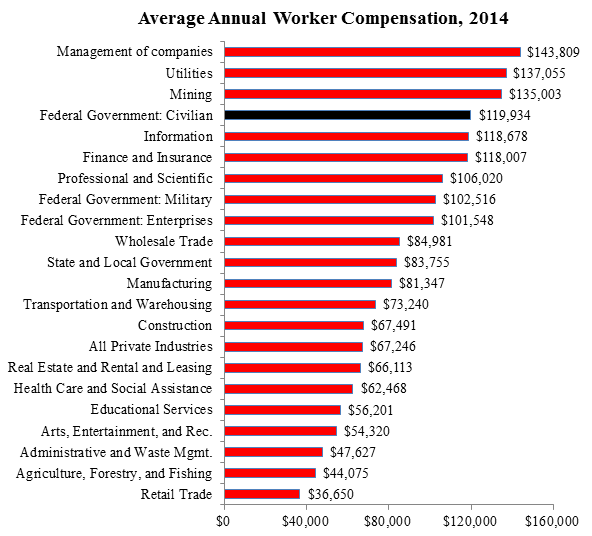Federal Government Pay Exceeds Most IndustriesBy Chris EdwardsCato @ Liberty Oct. 05, 2015 |
Popular 
Claim Jewish Student Was 'Stabbed In The Eye' by Pro-Palestine Protester Draws Mockery After Video Released

Mike Johnson Pushes Debunked Lie That Israeli Babies Were 'Cooked in Ovens' On October 7

'These Protesters Belong in Jail': Gov. Abbott Cheers Arrest of Pro-Palestine Protesters at UT Austin

'It Has to Be Stopped': Netanyahu Demands Pro-Palestine Protests at U.S. Colleges Be Shut Down

Senate Passes $95B Giveaway to Israel, Ukraine, and Taiwan, Combined With TikTok Ban
 New data show that worker compensation is rising faster in the federal government than in the private sector. After rapid growth in federal pay during the George W. Bush years, growth slowed from 2011 to 2013 after policymakers enacted a partial freeze on federal wages. That era of restraint is now over. The latest data from the Bureau of Economic Analysis (BEA) show that wages rose 2.9 percent in the federal government in 2014, on average, compared to 1.7 percent in the private sector. When benefits such as pensions and health care are included, federal compensation increased 2.8 percent, on average, compared to 1.3 percent in the private sector. Federal civilian workers had an average wage of $84,153 in 2014, compared to an average in the private sector of $56,350. The federal advantage in overall compensation (wages plus benefits) is even greater. Federal compensation averaged $119,934 in 2014, which was 78 percent higher than the private-sector average of $67,246. This essay discusses trends in federal and private pay. The BEA provides compensation data by industry. The figure shows average compensation in 17 major private industry groups, as well as compensation for federal civilian workers, the military, state and local governments, and federal government enterprises (mainly the postal service). The federal government has the fourth highest paid workers in the United States, after utilities, mining, and the management of companies. Federal compensation is higher, on average, than compensation in the information, finance and insurance, and professional and scientific industries. Federal compensation is more than twice as high as compensation in the education industry, and it is more than three times higher than compensation in the retail trade industry.  For more information, see here. |



